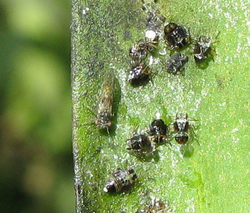| Acizzia uncatoides | |
|---|---|
 | |
| Acizzia uncatoides adults and nymphs showing sugars and sooty mould | |
| Scientific classification | |
| Domain: | Eukaryota |
| Kingdom: | Animalia |
| Phylum: | Arthropoda |
| Class: | Insecta |
| Order: | Hemiptera |
| Suborder: | Sternorrhyncha |
| Family: | Psyllidae |
| Genus: | Acizzia |
| Species: | A. uncatoides |
| Binomial name | |
| Acizzia uncatoides (Ferris & Klyver, 1932) | |
| Synonyms [1] | |
| |
Acizzia uncatoides is a species of psyllid native to Australia where it feeds primarily on Acacia (especially Acacia melanoxylon ) and some Albizia species. [2] It is present in many parts of the world where it infests these plant species, presumably introduced with the plants. It is not generally regarded as a pest species although it can proliferate to high numbers. Generalist psyllid predators also feed on this species.